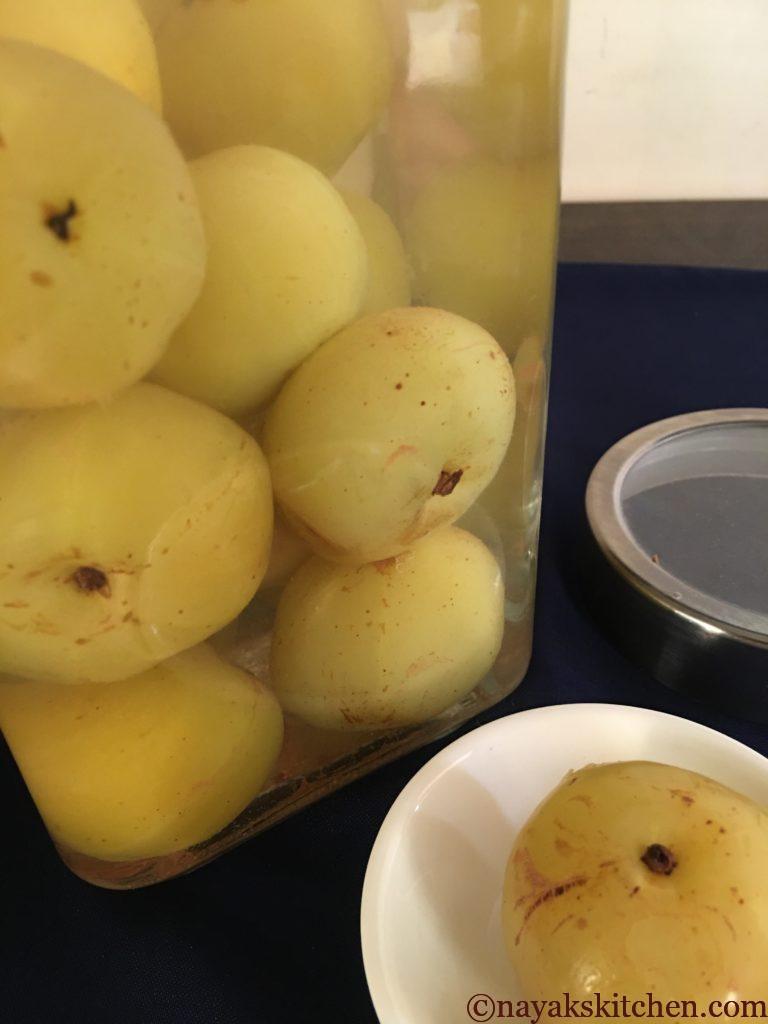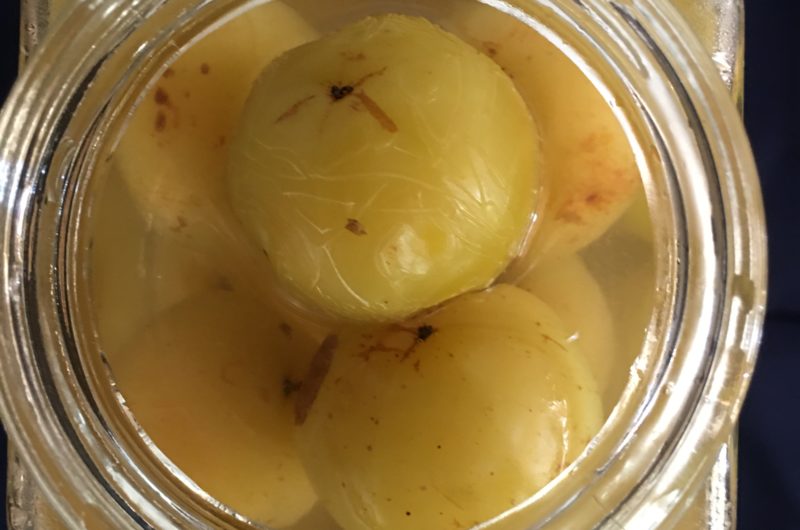
Salted Amla or Brined Amlas recipe with step by step photos and instructions.
What is Amla?
‘Amla‘ or the ‘Indian Gooseberry‘ or ‘Avalo‘ in Konkani is a fruit rich in vitamin C. It is sour, bitter, astringent to taste and contains a lot of fibre.
Fresh amlas are available between October to February. It is one of the lesser known superfoods. Do make the best out of it during the winters.
Ayurveda uses amla for its curing properties. It is known as ‘amlaki‘ in Sanskrit which means “nectar of life”. It can be eaten raw but because of its astringent and sour taste it is brined or converted to many recipes like pickles, murabbas, candies, jams etc.

Amlas start appearing in the markets during the autumn season and are available throughout the winters. Being a rich source of Vitamin C it therefore boosts immunity. Nature’s way of providing immunity during the harsh winters.
Amla is almost unpalatable in its raw form because of its astringent and sour taste. Hence, it is commonly kept in a brine solution to bring down its tartness. Brine is called as ‘khal‘ in Konkani and hence the term “khalatle avale“ which means salted amla or brined amla.
What is Brining?
Brining is the process of preserving something using a salt solution. Brining brings down the tartness and reduces the bitterness of amlas thus making them more palatable.
The salts get absorbed in the amla while boiling not only reducing its astringent taste but the process also makes them tender and soft.
How to make Salted Amla/Brined Amla
- Wash amlas 2-3 times with clean water. Drain the water and keep them aside.

2. Take 2-3 cups of water in a steel vessel. Water should be enough to soak the amlas. Adjust accordingly. Boil water and add 1 tbsp salt to it. I have used Himalayan salt (pink salt). You can use regular salt.

Cooking Amlas
3. Add amlas to the boiling salt water one by one.

4. Boil them for 4-5 mins till they become soft. Pierce a knife and check. Switch off the gas and allow it to cool.

5. Once cooled, store the amlas along with the salt water in a glass or ceramic bottle. Let the amlas get brined well in the salt solution for 2-3 days.
6. Serve as an accompaniment with meals.

Tips to store salted amla
- Always use glass or ceramic bottles to store the salted amlas. Do not use plastic containers.
- Refrigerate them for a longer shelf life.
Salted Amla | Brined Amla | Khalatle Avale
Course: AccompanimentCuisine: IndianDifficulty: Very Easy10
minutesBrined amlas which can be served as an accompaniment with meals.
Ingredients
1 cup = 250 ml
1 tbsp = 15 ml
Amlas/Indian Gooseberries/Avale – 12-15 nos.
Salt – 1 tbsp
Water – 3-4 cups (Just enough to immerse the amlas. Adjust accordingly.)
Directions
- Wash amlas 2-3 times well with clean water. Drain the water and keep them aside.
- Take 2-3 cups of water in a steel vessel. Water should be enough to immerse the amlas. Adjust accordingly.
- Boil water and add 1 tbsp salt to it. I have used Himalayan salt (pink salt). You can use regular salt.
- Add amlas to the boiling salt water one by one.
- Boil them for 4-5 mins till they become soft. Pierce a knife and check. Switch off the gas and allow it to cool.
- Refrigerate the amlas or else a layer of fungus starts developing over them.
- Once cooled, store the amlas along with the salt water in a glass or ceramic bottle. Let the amlas get brined well in the salt solution for 2-3 days.
- Serve as an accompaniment with meals.
Notes
- Always use glass or ceramic bottles to store the salted amlas. Do not use plastic containers.
- Refrigerate them for a longer shelf life.






